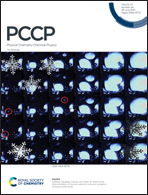Photophysical properties of N-methyl and N-acetyl substituted alloxazines: a theoretical investigation†
Abstract
The electronic structure and photophysical properties of a series of N-methyl and N-acetyl substituted alloxazines (AZs) were investigated with extensive density functional theory (DFT) and time-dependent density functional theory (TD–DFT) based calculations. We showed that non-radiative decays from the lowest singlet and triplet excited states of these AZs are dominant over their radiative counterparts. The fast non-radiative decays of the excited AZs can be attributed to the energy consumption (Ereorg) through structural reorganization facilitated by the intrinsic normal modes of the alloxazine framework, as well as their coupling with those of the functional groups. Substitution with functional groups may lead to further perturbation of the electronic structure of the AZ chromophore, which may enhance intersystem crossing with the ππ* states of the AZs. Due to the different bonding of N1 and N3 within the alloxazine framework, substitution may result in AZs with different photophysical properties. Specifically, functionalization at N1 may help in maintaining or even reducing Ereorg and would promote the absorption and radiative decay from the excited AZs. However, the strong coupling of the vibrational modes of acetyl at N3 with the intrinsic normal modes of the alloxazine framework would contribute significantly to Ereorg, and benefit the non-radiative decay of the excited AZs. We expect that the findings would pave the way for rational design of novel AZs with extraordinary photophysical properties.



 Please wait while we load your content...
Please wait while we load your content...